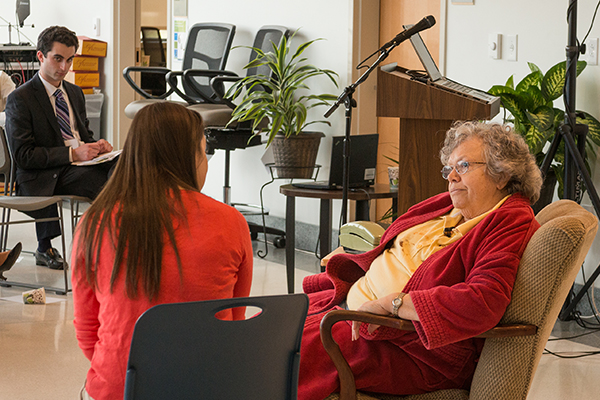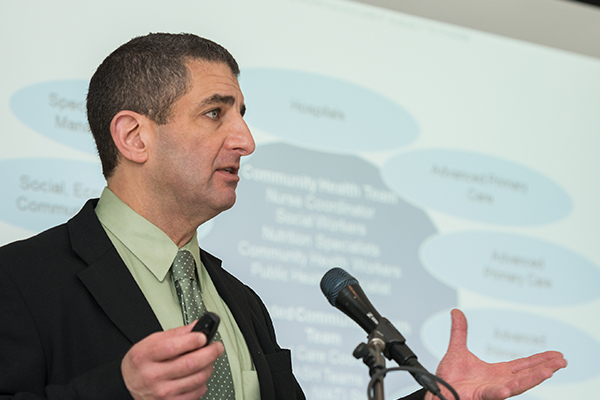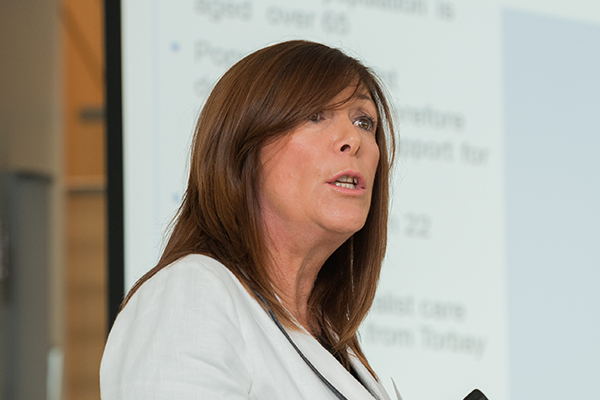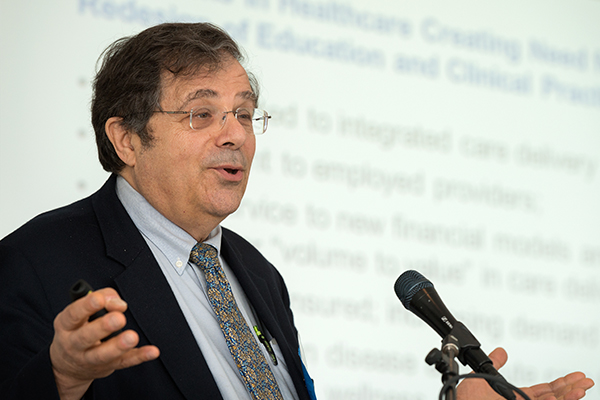

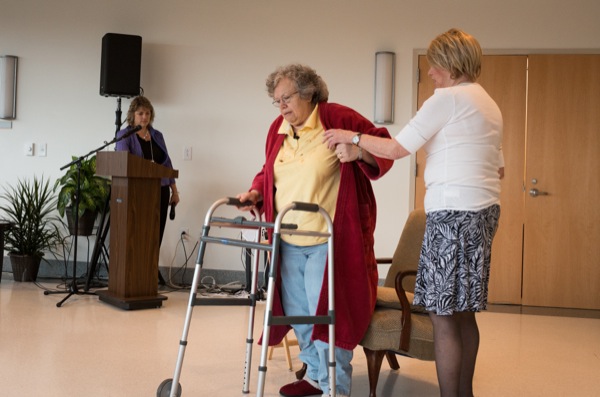
Health care symposium
Event addresses challenges in providing comprehensive patient-centered care
10:31 a.m., April 28, 2014--Florence, a 72-year-old widow, is sitting in her living room when the phone rings.
It’s the pharmacist calling to express concern about potential interactions between a new prescription she’s been given for depression and the 18 other drugs she’s taking for a host of medical problems — from hypertension and high cholesterol to coronary artery disease and heart failure.
Campus Stories
From graduates, faculty
Doctoral hooding
Within the next few hours, Florence is shuttled to two medical offices by a kind but harried neighbor, and she tells her health care story, over and over, to a succession of nurses and doctors. Throughout the experience, she’s lugging an oxygen tank and supporting herself with a walker because her feet are swollen and she’s worried about falling.
At the end of the day, Florence is frightened, confused, and exhausted.
Act I
Florence is an actress, Linda Henker, and on Tuesday, April 8, she was part of a performance put on by the University of Delaware’s Healthcare Theatre Program during a daylong Delaware Healthcare Workforce Symposium.
The program, which helps health care professionals develop communication skills through interactive scenarios presented by theatre students, was given a new twist for the occasion — this time, the goal was to demonstrate the need for patient-centered integrated care.
“Healthcare Theatre students are trained to be a voice for the patient,” said Amy Cowperthwait, a nursing instructor who co-founded the program with Allan Carlsen, assistant professor in the theatre department. “Florence is not only worried about her medications and her health — she also has concerns about transportation and costs. This scenario demonstrates that we need to be aware of a person’s overall situation and be sensitive to it when we plan and deliver care.”
Some groups across the U.S. as well as in other countries have initiated programs to implement coordinated care, and three leaders in workforce innovation were invited to share their perspectives on what works and what doesn’t.
A common theme in the three keynote presentations was the need to integrate health care and social services.
Vermont Blueprint for Health
“Addressing this issue is as much about human services as it is about health care,” said Craig Jones, director of the Vermont Blueprint for Health. “We have to consider things like transportation and housing, and we need to come up with solutions, not focus on what’s wrong.”
The Vermont Blueprint for Health is a statewide public-private initiative to transform care delivery, improve health outcomes, and provide all citizens in the state with seamless, well-coordinated care.
To meet these goals, community health teams work with primary care providers to assess patients’ needs, coordinate community-based support services, and deliver multidisciplinary care. A web-based central health registry captures patient data.
“Our goal is to link people to the social, economic, mental health, and other services they need,” Jones said.
So far, the approach has resulted in reduced medical expenditures per capita and successfully linked the Medicaid population to non-medical support services.
Health and social care in Torbay
Mandy Seymour provided highlights of a similar program in England, the Torbay and Southern Devon Health and Care NHS Trust. Seymour is credited with piloting an integrated health and social care model across a region with a population of about 140,000 people, many of whom are elderly and have little family support.
In Torbay, all calls from patients and providers come in to health and social care coordinators, who then direct the calls as needed to follow the best path for the patient.
“We have a Mrs. Smith who is very much like your Florence,” Seymour said. “She was created to convey a clear message across the system to rally providers around the need for change. At the beginning, she was surrounded by a lot of unconnected puzzle pieces. Our goal was to put those pieces together in a way that provides her with the right care at the right time in the right place.”
Through this approach, long-term residential care has been cut by about half, and the number of calls to 999 — the U.K. version of 911 — has decreased.
“With one pot of money for health care and social care, we’ve achieved good outcomes at a reduced cost,” Seymour said.
National Center for Interprofessional Practice and Education
Frank Cerra, a physician who serves as senior adviser to the National Center for Interprofessional Practice and Education at the University of Minnesota, pointed to the need for learners to be part of the system.
“We have to bring education and collaborative practice back together, or the change in culture will fail,” he said. “You can’t design workforce training until you have a model of care.”
Cerra used the classic tale of the blind man and the elephant to illustrate the current state of health practice, with everyone “seeing” something different when they touch just one part of the creature. In this case, different people see health care as a health professions education system, a payment system, a health delivery system, and so on.
“The problem is that people come together from different disciplines and then parallel play in the sandbox,” Cerra said.
In the vision he shared for a transformed health system, education and practice come together, leading to partnerships and improved patient experience of care, improved population health, and reduced per capita cost of health care.
Delaware innovations
Tom Stephens, chief medical officer at Westside Family Healthcare, highlighted a few of the many institutions and programs in Delaware that are working to address the needs to coordinate care and reduce costs.
These include UD’s Nurse Managed Health Center Satellite Office at Horizon House, which provides onsite primary care for individuals with chronic mental health problems; Project ECHO, which uses telemedicine to improve the management of patients with complex conditions; and the Delaware Cancer Consortium, which provides care coordinators to guide patients through testing and treatment.
Stevens also cited programs at several hospitals, including Christiana Care, Beebe Medical Center, and Nanticoke Health Services.
Act II
Healthcare Theatre is basically improv, and improv took on a whole new meaning with the second performance of the day — the “after” scenario, where Florence was finally given a voice and some help.
Symposium participants were invited to serve as members of her health care team, which included a care coordinator. To make it easier for Florence, who has issues with transportation, the scenario used telehealth to bring the providers to her.
Discussion after the scenario focused on how the new approach worked, as well as potential barriers to implementation. Florence’s eating habits and swollen ankles pointed to the need for a nutrition expert to be part of her team, while her complex set of medical problems drew attention to payment issues and annual insurance caps on services such as physical therapy.
Breakout discussions after the scenario focused on the skills needed for care coordination and integrated care, and the groups then shared their lists with the other participants. Desirable traits included clinical knowledge and resources, technical skills, interpersonal and organizational skills, and cultural competency.
“I can’t help but think about Florence’s experience this morning,” said UD College of Health Sciences Dean Kathy Matt at the end of the conference. “It was very sad, but unfortunately very realistic. Health care needs to be headed towards a more integrated and comprehensive care model, centered on the patient.”
“This is why we are utilizing education models that focus on interprofessional training with an emphasis on the development of communication and psycho-social support skills. This example illustrates why our education models in the college are interprofessional and interdisciplinary – this is where health care is headed, and it is critical for us to be responsive to that need.”
The event drew more than 100 representatives from hospitals, state agencies, academic institutions, clinics, nonprofits, and professional organizations.
Article by Diane Kukich
Photos by Kathy F. Atkinson




